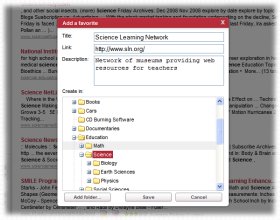|
Education
Web
Viewing 1-3 of 3 total results
Eat Like A Bird
(everyone asks questions) and inter-disciplinary lesson (Math, Science, and Technology). It is suitable for all learners through the use of Multimedia (audio, video, and graphics). It is appropriate for small and varied grouping of four members and mixed ability groups. The tasks include the use o...
based upon their observations about the natural world and design a simple investigation. S:SPS3:4:2.3 Develop questions that help them learn about the environment; and design and conduct simple investigations. S:SPS3:4:2.4 Locate and collect information about the environment and environmental an...
1
0
based upon their observations about the natural world and design a simple investigation. S:SPS3:4:2.3 Develop questions that help them learn about the environment; and design and conduct simple investigations. S:SPS3:4:2.4 Locate and collect information about the environment and environmental and natural resources topics. S:SPS3:4:2.5 Use reliable information to answer questions. S:SPS3:4:2.6 Organize information to search for relationships and patterns concerning the environment and
22
0
http://www.ed.state.nh.us/education/doe/organization/curriculum/CurriculumFrameworks/documents/ScienceFramework.pdf#page=22
www.ed.state.nh.us/education/doe/organization/curriculum/CurriculumFramew...
based upon their observations about the natural world and design a simple investigation. S:SPS3:4:2.3 Develop questions that help them learn about the environment; and design and conduct simple investigations. S:SPS3:4:2.4 Locate and collect information about the environment and environmental and natural resources topics. S:SPS3:4:2.5 Use reliable information to answer questions. S:SPS3:4:2.6 Organize information to <span class="highlight">search</span> for relationships and patterns concerning the environment and
include material, energy, or information) can become the input to other parts. This is evident, for example, when students: s compare systems with internal control (e.g., homeostasis in organisms or an ecological system) to systems of related components without internal control (e.g., the Dewey deci...
1
0
include material, energy, or information) can become the input to other parts. This is evident, for example, when students: s compare systems with internal control (e.g., homeostasis in organisms or an ecological system) to systems of related components without internal control (e.g., the Dewey decimal, solar system). 2. Models are simplified representations of objects, structures, or systems used in analysis, explanation, interpretation, or design. Students: • select an appropriate model to begin the search for
5
0
http://www.emsc.nysed.gov/ciai/mst/pub/mststa6_7.pdf#page=5
www.emsc.nysed.gov/ciai/mst/pub/mststa6_7.pdf#page=5
include material, energy, or information) can become the input to other parts. This is evident, for example, when students: s compare systems with internal control (e.g., homeostasis in organisms or an ecological system) to systems of related components without internal control (e.g., the Dewey decimal, solar system). 2. Models are simplified representations of objects, structures, or systems used in analysis, explanation, interpretation, or design. Students: • select an appropriate model to begin the <span class="highlight">search</span> for
|
